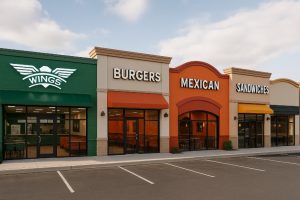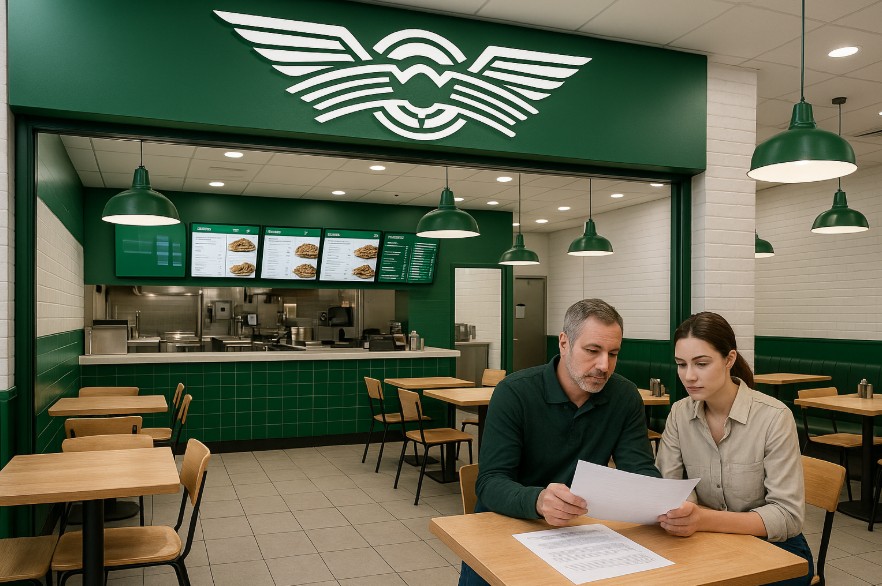Wingstop has rapidly evolved from a small wing restaurant in Texas to a global fast-casual powerhouse with thousands of locations worldwide.
For entrepreneurs considering entering the quick-service restaurant sector, Wingstop presents an attractive opportunity. But what exactly does it cost to own a Wingstop franchise, and what kind of returns can be expected?
This guide provides a professional breakdown of the costs, fees, earnings, and potential risks involved in becoming a Wingstop franchisee, particularly for UK-based investors.
What Is the Total Cost to Open a Wingstop Franchise?

The total cost of opening a Wingstop franchise varies widely depending on factors such as location, restaurant size, local construction costs, and staffing requirements. Typically, the investment required to establish a new Wingstop ranges from $326,000 to $975,000.
This cost includes a wide range of one-time expenses such as securing a lease, fitting out the space, purchasing equipment, and marketing for the launch.
Key Startup Costs Breakdown
| Cost Category | Low Estimate | High Estimate |
| Initial Franchise Fee | $10,000 | $20,000 |
| Security Deposits | $0 | $10,000 |
| Store Build-Out & Improvements | $155,000 | $570,000 |
| Furniture and Equipment | $56,000 | $147,000 |
| Décor Package | $12,000 | $32,000 |
| Signage | $4,000 | $39,000 |
A few costs are variable and may be influenced by local market conditions in the UK:
- Lease costs depend on city and high street visibility
- Labour and material prices can shift due to inflation
- Specific design and regulatory requirements may influence construction costs
Wingstop provides a detailed cost estimate to approved applicants, tailored to the location and projected layout.
What Are the Ongoing Fees Associated with a Wingstop Franchise?
Once the store is operational, the franchisee is expected to pay regular fees to Wingstop as part of the franchise agreement. These fees support brand development, marketing, training, and corporate operations.
Breakdown of Regular Franchise Fees:
| Fee Type | Amount |
| Royalty Fee | 6% of gross sales |
| National Advertising Fund | 4% of gross sales |
| Local Advertising | None required |
| Non-Reporting Fee | $250 |
| Website Maintenance Fee | $25 per month |
| Supplemental Training | Up to $1,000 per trainer plus expenses |
These fees ensure each franchisee receives the tools and support needed to operate efficiently. The advertising fund supports national marketing campaigns, while the royalty fee helps maintain brand value across all territories.
How Profitable Is a Wingstop Franchise?
Wingstop’s financial performance as a franchisor highlights its stability and growth potential. For franchisees, the brand’s global footprint, consistent consumer demand, and operational model provide favourable conditions for profitability.
According to the most recent data, Wingstop has achieved 21 consecutive years of same-store sales growth. Its growth metrics reflect strong operational efficiency and market penetration.
Financial Highlights from 2024
| Metric | Value |
| Total Global Locations | 2,563 |
| System-Wide Sales Growth | 27% |
| Adjusted EBITDA Growth | 34% |
| Cash Conversion Rate | 75% |
| Shareholder Return Since IPO | 1,919% |
These figures suggest a scalable model with strong financial foundations. While individual profits vary, Wingstop’s unit-level economics are designed to support consistent earnings once break-even is achieved.
Some factors influencing franchisee profitability include:
- Location footfall and delivery coverage
- Effective staff management and cost control
- Ability to attract repeat customers through customer experience and menu quality
What Are the Franchise Requirements for Wingstop?

Wingstop maintains a clear set of requirements for franchise applicants to ensure operational capability and alignment with its brand mission. This approach helps protect the business model and ensures that franchisees have the resources necessary to succeed.
Typical criteria include:
- A net worth of at least $1.2 million
- Liquid assets totalling $600,000
- Capacity to manage single or multi-unit operations
- Business or operational experience, preferably in food and beverage
Franchisees are expected to operate their units directly or employ experienced managers to uphold brand standards. Wingstop often encourages multi-unit development, especially in high-growth international markets.
How Does Wingstop Support Franchisees?
One of the advantages of investing in a Wingstop franchise is the comprehensive support provided throughout the ownership journey. Wingstop’s franchise model is designed to offer operational simplicity, and its systems are set up to assist both first-time and experienced entrepreneurs.
Support offered includes:
Pre-Opening Assistance:
- Site selection and lease negotiation guidance
- Store design and build-out support
- Vendor recommendations for equipment and décor
Training and Operations:
- Extensive initial training for franchisees and staff
- Ongoing coaching for operational improvement
- Access to manuals, SOPs, and reporting tools
Marketing and Branding:
- Participation in national campaigns
- Social media and digital marketing assets
- Guidance on local marketing execution
Technology and Logistics:
- POS systems and performance dashboards
- Supply chain access and vendor relationships
By standardising support processes and equipping franchisees with tools for performance tracking, Wingstop ensures operational consistency and business health.
Is Wingstop a Good Franchise Opportunity in the UK?
Wingstop has already made a significant entry into the UK market with restaurants in cities such as London, Manchester, and Reading. Its brand message, focusing on bold flavours and a streamlined menu, resonates with a growing UK audience that values fast-casual dining experiences.
Key factors supporting Wingstop’s success in the UK include:
- Increasing popularity of chicken-focused fast food
- Youth demographic engagement through social media
- Simplified menu and high average transaction value
The UK fast-casual sector remains competitive, but Wingstop’s differentiated menu and strong branding position it as a compelling alternative to conventional fast food chains.
Investors evaluating UK franchise opportunities should consider market trends, local dining habits, and urbanisation patterns to identify potential success zones.
How Is Wingstop Performing Financially in 2025?

Wingstop’s fiscal first quarter 2025 results reveal robust growth across several key performance indicators. The company has continued to expand its global footprint and drive digital engagement, while delivering significant revenue and income gains.
During the thirteen weeks ending 29 March 2025, Wingstop reported system-wide sales of $1.3 billion, marking a 15.7% increase compared to the same period in 2024. The company opened a record 126 net new restaurants, nearly doubling its growth from the previous year’s first quarter.
Key Highlights from Q1 Fiscal 2025
| Metric | Q1 2025 | Q1 2024 | Change |
| System-wide Sales | $1.3 billion | $1.12 billion | +15.7% |
| Net New Openings | 126 | 65 | +93.8% |
| Domestic AUV | $2.1 million | $1.9 million | +11.3% |
| Same Store Sales (Domestic) | +0.5% | +21.6% | Normalised growth |
| Digital Sales (% of Total Sales) | 72.0% | Not disclosed | High digital penetration |
| Total Revenue | $171.1 million | $145.8 million | +17.4% |
| Net Income | $92.3 million | $28.7 million | +221.0% |
| Adjusted EBITDA | $59.5 million | $50.3 million | +18.4% |
| Adjusted Earnings per Diluted Share | $0.99 | $0.98 | Stable performance |
Performance Drivers
Several key trends contributed to Wingstop’s performance in early 2025:
- Digital sales reached 72% of total system-wide sales, driven by investments in mobile and delivery channels.
- Average unit volume (AUV) rose to $2.1 million, reflecting increased consumer demand and efficient operations.
- Net income growth was supported by a significant gain from the sale of the company’s UK franchise investment, which contributed to an adjusted net income of $28.3 million.
Operating and Expansion Momentum
Wingstop’s expansion strategy remains on pace, with 2,689 total system-wide restaurants at the end of Q1 2025 compared to 2,279 in Q1 2024. This includes:
- 2,250 domestic franchise restaurants
- 388 international franchise locations
- 51 company-owned units
Domestic growth was particularly strong, with 96 new franchise locations opened during the quarter.
The CEO, Michael Skipworth, noted that despite a challenging macroeconomic climate, the brand’s model showed resilience and scalability, moving it closer to its goal of becoming a Top 10 Global Restaurant Brand.
What Are the Key Pros and Cons of Owning a Wingstop Franchise?
Like any franchise model, Wingstop presents both opportunities and challenges. Prospective franchisees should assess these carefully against their business goals.
Pros of Owning a Wingstop Franchise
- Recognised and growing brand with international reach
- Operational model focused on a narrow, efficient menu
- High customer retention and repeat business
- Support across marketing, operations, and logistics
- Scalable potential for multi-unit ownership
Cons of Owning a Wingstop Franchise
- High upfront investment and capital requirements
- Stringent operational and branding compliance
- Recurring royalty and marketing fees reduce net margin
- Market competition from both large and local QSR brands
The success of any franchise depends on the operator’s involvement, market understanding, and commitment to following the brand’s systems.
How Can You Apply for a Wingstop Franchise?
For UK-based entrepreneurs, the process of applying for a Wingstop franchise begins with an online application through the company’s franchise development portal. Following this, selected candidates undergo a detailed review process.
Steps to apply include:
- Submitting a formal expression of interest on the official site
- Providing financial credentials and business background
- Reviewing the Franchise Disclosure Document and legal terms
- Attending a Discovery Day to meet the corporate team
- Securing site approval and franchise agreement sign-off
- Undertaking franchisee training before restaurant build-out
Wingstop’s franchising team evaluates applicants on financial strength, operational experience, and readiness to develop within the brand framework.
How Does Wingstop Compare to Similar Franchise Opportunities?

To evaluate Wingstop’s competitiveness in the franchise landscape, it’s helpful to compare it with other fast-casual and chicken-focused franchise brands. This helps potential investors understand the relative investment, profitability, and support levels among similar options.
Comparison Table: Wingstop vs Other Popular Chicken Franchises
| Feature | Wingstop | Popeyes | Chick-fil-A | KFC |
| Initial Investment Range | $326,000 – $975,000 | $383,500 – $3,545,800 | $342,990 – $1,982,225 | $1.4M – $2.7M (UK average) |
| Franchise Fee | $10,000 – $20,000 | $50,000 | $10,000 | £25,000 – £30,000 (UK) |
| Royalty Fee | 6% | 5% | 15% of sales | 6% |
| Ad Fund Contribution | 4% | 4% | Varies (typically 5%) | 5% |
| Number of Global Locations | 2,563 | 4,000+ | 3,000+ | 25,000+ |
| Multi-Unit Opportunities | Encouraged | Available | Limited | Available |
| International Expansion | Actively expanding in UK | Established in UK | Not widely available | Strong UK presence |
Analysis of Key Differences
- Cost to Start: Wingstop has a relatively low barrier to entry compared to KFC and Popeyes, which often require higher investment due to larger restaurant formats and more complex menus.
- Royalty and Fees: Wingstop maintains moderate fees compared to Chick-fil-A, which charges a high royalty and controls much of the business operations.
- Operational Model: Wingstop focuses on a limited menu of wings, sandwiches, and sides, allowing for simpler operations compared to full-menu QSRs like KFC.
- Ownership Control: Chick-fil-A operates on an operator model with less ownership autonomy. In contrast, Wingstop allows more traditional franchise ownership and equity-building.
- UK Market Viability: Wingstop is still growing in the UK, offering more territory opportunities. KFC and Popeyes, while established, have saturated many prime markets.
Why Choose Wingstop Over Competitors?
- Lower capital requirement for initial setup
- Simplified operations due to a focused menu
- Strong brand appeal among younger demographics
- Active UK expansion, meaning more open territories and support
This comparison illustrates that Wingstop holds a strong position for investors looking to enter or expand in the fast-casual chicken segment with a balance of cost efficiency and growth potential.
Conclusion
A Wingstop franchise offers an attractive mix of brand strength, proven profitability, and growth potential. However, the decision must be backed by thorough due diligence, a solid financial foundation, and a clear understanding of the UK food industry.
For investors seeking to enter a fast-growing, flavour-forward brand with robust global backing, Wingstop presents a compelling case. From initial franchise costs to long-term profitability, the opportunity may prove worthwhile for the right entrepreneur.
FAQs About Wingstop Franchise Cost and Profitability
What kind of return on investment can I expect from a Wingstop franchise?
Return on investment can vary, but Wingstop’s consistent sales growth and franchise model offer healthy potential for long-term profitability, especially with multi-unit operations.
Are there Wingstop locations already operating in the UK?
Yes, Wingstop is actively expanding in the UK with existing locations in cities like London and new developments planned in major urban centres.
How long does it take to open a Wingstop franchise?
Typically, it takes around 6–12 months from initial approval to opening day, depending on construction, location, and permit timelines.
Does Wingstop help with site selection in the UK?
Yes, Wingstop provides comprehensive assistance with site selection, using demographic analysis and market research tools to ensure the best possible location.
Can I open multiple Wingstop units?
Wingstop encourages multi-unit development, especially in emerging markets like the UK. However, approval depends on your financials and operational capabilities.
Is restaurant or franchise experience required to apply?
While not mandatory, prior experience in the restaurant or franchising industry is highly beneficial and often preferred by Wingstop during the approval process.
What are the biggest risks of owning a Wingstop franchise?
Key risks include high upfront investment, market saturation, and the operational pressure of maintaining brand standards. Understanding and mitigating these is essential.








